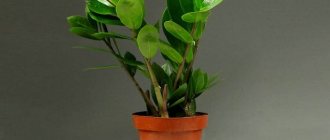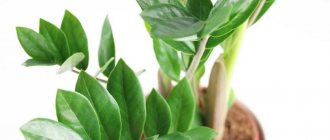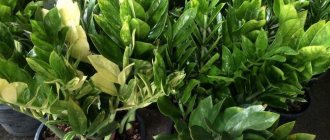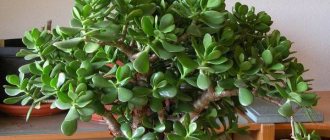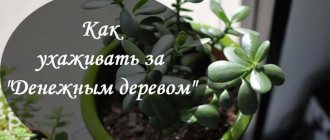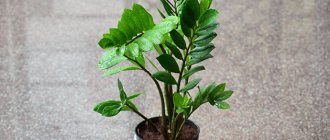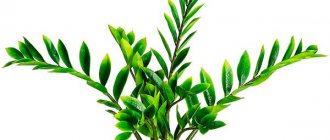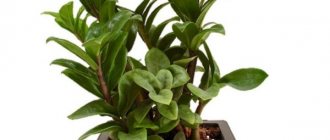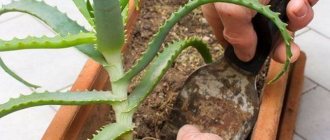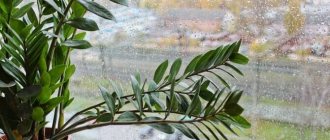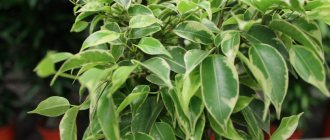Rules for caring for Zamioculcas
The dollar tree comes from Africa, so the best location for it is the south side of the room. For normal growth it needs diffused light. In summer you can take the flower outside. You should avoid direct sunlight, which can cause burns on the leaves.
Dollar tree is an unpretentious houseplant
Since the tree is capable of accumulating water, it should be watered abundantly, but not often. The pan should remain dry; the next watering should be done only after the earthen clod has dried.
As a rule, in winter it is enough to water once a week, in summer more often. Water should stand for 12 hours before watering.
Important! Excess moisture can lead to yellowing of leaves, root rot and plant death. Therefore, before the next watering, you should make sure that the soil is sufficiently dry, and that after watering there is no excess moisture left in the pan.
The soil for the flower must be well-drained. A mixture suitable for cacti and succulents. Or you can mix turf soil, sand, leaf soil, peat and sphagnum moss. A quarter of the pot should be drainage. The money tree does not like clay soil, as it accumulates excess moisture, which is dangerous for the plant.
Instead of regular spraying, Zamioculcas should be washed from dust in the shower from time to time. However, if the air is extremely dry, the plant should still be sprayed periodically.
In what soil should zamioculcas be planted for good flower growth?
If you are looking for an easy-to-care plant that has an original appearance, we recommend paying attention to Zamioculcas, which is popularly called the “dollar tree.”
The appearance of the plant really resembles everyone’s favorite “money tree”, although the indoor flower in question has leaves that are more massive and powerful.
Choosing soil, pot, fertilizers
Zamioculcas is an exotic plant. Despite this, it is completely unpretentious in care. Proper selection of soil is the first rule that will help the plant go through a period of acclimatization and easily take root in the conditions that the grower provides it. "Dollar tree" prefers loose soil into which water and air easily penetrate.
In flower shops, anyone can purchase universal soil for this type of plant. However, you can prepare the soil at home.
You just need to mix black soil and sand in equal proportions. The prepared soil should be “airy” for water and air. By the way, you can loosen the soil not only with sand, but also with expanded clay and chopped sphagnum. Don't forget about drainage, which will increase the ability to "deep breathe." Remember that the drainage layer should not be too thick, just a couple of centimeters is enough.
- The pot should be 3-4 centimeters larger than the root system of the plant (lengthwise and crosswise).
- Pot material. It should be understood that zamioculcas is an exotic plant, so stagnation of water in the pot should not be allowed. Give preference to a clay pot; it circulates air and water well, providing additional ventilation to the root system.
- Appearance. "Dollar Tree" looks impressive in elongated pots. They are often called “vase-shaped” dishes for indoor plants.
The most popular fertilizers recommended by gardeners are:
- Agricola. Fertilizer is applied by watering the plant. The product does not contain chlorine. When using the product, it must be applied directly into the ground, being careful not to get Agricola on the green leaves.
- Agricola Aqua. The fertilizer does not need to be diluted; it is sold ready-made. The effect of the fertilizer is aimed at enhancing plant growth, accelerating and prolonging flowering.
- Pokon. The fertilizer is intended for cacti, but the mineral complex that is part of the drug is well tolerated by zamioculcas and has a positive effect on the growth and flowering of indoor plants. The drug is dangerous for animals and humans; the packaging of the finished product should be stored in a dark, dry place.
The right choice of soil, pot and fertilizer will help a foreign guest to settle down in our difficult climatic conditions as quickly as possible.
Basic rules for caring for the dollar tree
Zamioculcas is not averse to basking in the sun, so when choosing a place, give preference to the sunny side of the house, but remember that the flower still needs to be darkened to avoid sunburn. An important point is to create the right conditions for the indoor plant.
Temperature and humidity
In summer, the optimal temperature for zamioculcas is considered to be +25 degrees Celsius. In winter, the air temperature can be lowered to +16. This will help create conditions for active plant growth in the summer.
Flower growers recommend placing the pot with the plant on the balcony, and the thermometer should not show a mark below +12 degrees Celsius. Since Zamioculcas came to us from distant Africa, it simply needs good humidity.
It is optimal if the humidity in the room is between 60-70%. In the summer, such a picture can easily be imagined, but during the heating season there are two ways to achieve ideal humidity: buy a humidifier or lay a wet towel on the radiator. And don’t forget to carefully wipe the leaves with a damp, soft cloth.
Watering Zamioculcas
Zamioculcas is a succulent, which means it needs plenty of soil moisture. Remember the most important rule - you need to water the plant only when the soil is dry. If you flood the plant, you may encounter the problem of root rot, and then the plant can no longer be saved.
Flower growers recommend settling and filtering water. This will help soften it and precipitate such unwanted chlorine. In summer, the plant is watered up to 3 times a week; in winter, watering is reduced to once every 7 days.
Zamioculcas flowering is a very rare phenomenon, but incredibly beautiful. Only with proper and competent care can you see how the plant blooms. Today, the dollar tree is a real decoration of residential buildings and offices. Thanks to its waxy leaves, zamioculcas brings a touch of originality to the room!
Tags: #How to fertilize a dollar tree
The importance of fertilizing and signs of nutrient deficiency
Nutrient deficiency affects, first of all, the appearance of the plant.
Nutrient deficiency affects the appearance of the plant
The flower signals the need for feeding:
- yellowing, wilting or falling leaves;
- the formation of spots on the leaves;
- throwing out shoots.
During the growing season (spring-summer), the tree is fed twice a month. This is a period of active growth when additional supply of nutrients is extremely important. While in winter the tree is at rest, so it does not need feeding.
Description
In fact, scientifically this plant has an even funnier name: Zamioculcas zamiifolia, because it resembles zamia, a rare gymnosperm plant. What's unusual about his appearance? And the fact that its trunk is a tuber with water reserves located in the ground. And all these “sticks with leaves” are leaves of an unusual feathery shape, which are often mistaken for trunks. Sometimes they are up to a meter long. The leaves are so close to each other that they seem to form a rosette.
The flower of Zamioculcas is unusual and inconspicuous at the same time: a small cob, similar to young corn, wrapped in a sail-shaped petal-veil. It blooms almost at the very base of the trunk, so it is not noticeable. Therefore, Zamioculcas can be considered a 100% ornamental deciduous plant.
And the leaves are indeed very attractive: regular in shape, almost always the same in size and covered with a natural waxy coating, which not only protects the leaves in places where they grow naturally from sunburn and moisture evaporation, but also gives the plant a shiny, polished appearance.
- Types of nolina in the photo with names
Types of Fertilizers for Dollar Trees
To feed Zamioculcas, special fertilizers for cacti and succulents are suitable, in addition, you can use universal formulations. The mixture must be introduced into moist soil. All universal fertilizers, as a rule, are diluted in a slightly higher proportion than for flowering plants.
In addition, experienced gardeners advise foliar feeding - spraying plants with fertilizers at the rate of 1 gram per liter of water.
Important! It should be noted that you can only spray a healthy flower, without signs of wilting, no more than once every 2 weeks. During the flowering period, fertilizing is not performed.
Mineral and organic fertilizers are suitable for Zamioculcas, which must be alternated every two weeks.
Dollar Tree Fertilizers
Most often used:
- "Agricola" is a fertilizer with a balanced composition of nitrogen, potassium and phosphorus. For root feeding, the calculation is 1 teaspoon per 2 liters of water. Do not mix with other substances. When using, try to avoid contact with plant leaves.
- "Agricola-Aqua" is already on sale in ready-made liquid form. Has a beneficial effect on growth and long-lasting flowering.
- "Pokon" - suitable for all succulents. Produced ready-made. Stimulates plant growth and flowering.
- “Good Power” – it contains succinic acid, which is a growth stimulant. Helps strengthen the flower's immunity.
- “Master Color” is a universal fertilizer rich in iron. Stimulates flowering and helps prevent plant chlorosis.
Care must be taken with all fertilizers. Not only can they be toxic to humans, but excess and high concentrations can kill the plant.
Types of fertilizers for zamioculcas
Before using the preparations, you should remember that it is necessary to feed the crop on moist soil. Alternating organics and minerals is the optimal solution when processing plants.
Organic
Organic fertilizers are effective for fertilizing zamioculcas. It is recommended to use the following types:
- Manure or bird droppings.
Fresh material is poured into the container 1/3 full, water at room temperature is poured in. After 4 days, stir. The working solution is prepared by adding water in a ratio of 1:20 for manure or 1:25 for litter. The composition is used for root feeding.
- Compost.
The mixture is used in the form of mulch. The finished product should be laid on top of the pot's soil in a layer several centimeters high.
- Sapropel.
Lake sludge is sold in specialized stores in granular or liquid form. Before application, it is mixed with soil in a ratio of 1:10.
- Wood ash.
The substance is used dry or dissolved in water. It needs to be introduced into the soil at the rate of 2 tbsp. l. per 1 kg of soil, mix thoroughly. To prepare the solution, add 6 tsp to 1 liter of liquid. ash, leave for 7 days. Water the plant at the rate of 100 ml of the prepared composition per liter pot.
- Sawdust.
This material is applied to the soil as mulch.
- Peat.
The rock is scattered over the soil surface in a layer of 5-6 cm and mixed with the top layer of soil.
Preparing plant food with your own hands
You can also fertilize the plant yourself. Sugar, glucose, potato peelings, castor oil, wood ash, eggshells and even fish bones are great for this.
Dollar Tree Fertilizers
Here are some homemade fertilizer recipes:
- Sugar. Dissolve a tablespoon of sugar in a liter of water. Use no more than once a month. Promotes rapid growth.
- Banana. Pour 2 banana peels with 2 liters of hot water and leave for three days. This fertilizer is rich in potassium, which activates plant growth.
- Yeast. Dilute 11 g of yeast, 2 tablespoons of sugar with 3 liters of water, leave for 2 hours. This fertilizer also affects the growth of the plant and makes the leaves more shiny.
Ready-made fertilizers
The most commonly used fertilizers are:
- Agricola. This fertilizer does not contain chlorine and is highly soluble in water. It has a balanced composition with a large number of elements. To feed zamioculcas, you need to dissolve a teaspoon of fertilizer in two liters of water. Watering is carried out once every 10 days, making sure that the aqueous solution does not get on the leaves and stem. It is not recommended to mix Agricola with other chemicals. You just need to follow safety rules so that chemical elements do not accidentally get on your mucous membranes.
- Pokon. Dutch fertilizer for cacti, which can be used immediately, without additional preparation. But you need to be careful; it is not safe for living creatures, unlike Zamioculcas, which reacts to it very favorably.
- Agricola Aqua. Popular fertilizer, ready to use. It is useful for accelerating flowering and enhancing growth.
Timing and frequency of feeding
In early spring, the plant enters the growth phase. Then it is worth making the first fertilizing. Further saturation of the plant with nutrients should be done 2 times a month until the end of summer, by spraying and root feeding of the plants. For foliar feeding, the concentration of fertilizers should be 10 times less than when watering.
In the autumn-winter period, the flower is dormant; during this period of time it is better not to fertilize at all, reduce watering and put the plant in a cool (up to 16 ° C), dark place. Over the winter it will gain strength before a period of active growth.
Characteristics of the plant
The evergreen shrub belongs to the aroid family, and its requirements are somewhat reminiscent of succulents. Perhaps this is due to the fact that in natural conditions it often grows next to them. Therefore, I got used to being content with poor soil and making reserves of moisture in case of drought. And there is a place to collect it, because the plant has thick stems and large juicy tubers. They, in fact, represent its root system.
Zamioculcas does not have a stem as such. The lush bush consists of tall and strong leaves, which are called compound leaves. On thick petioles, gradually thinning towards the top, oval leaves bloom on both sides. They are dark green in color and have a dense leathery structure. Such leaves grow one at a time, and the plant has neither a trunk nor lateral branches. It is noteworthy that the petioles grow directly from the underground tuber. From it, only in the lower part, thick, long roots grow.
Zamioculcas growth is very slow. Usually it produces no more than 3–4 young branches per year. The annual growth is no more than 15 cm. It can be called a long-liver, because the ornamental bush lives up to 10 years of age, and sometimes even more.
Does homemade Zamioculcas bloom?
Indeed, growing up to 1.5 m in height, this beauty is also capable of blooming. True, such a phenomenon can be seen very rarely, and not only at home, but also in nature. Only mature, one might even say old, specimens are capable of blooming. This happens in the spring, but sometimes in early autumn.
The flower itself is not of particular aesthetic value, although it is incredibly fragrant. In its structure, it is a bit like a calla flower: a long spadix wrapped in a blanket. At the same time, the bedspread is very small and inconspicuous, pale green. It is not wrapped around the cob, but bends down immediately below. The cob will also not surprise you with its bright color - it is creamy. So the main advantage of the plant is still the leafy part, and not the flowering.
It is interesting that after the end of flowering, Zamioculcas growing in nature begins to bear fruits - berries. Each one contains one seed. At home, seeds are not formed, including after artificial pollination.
Tips and tricks from our readers
How to feed a dollar tree if the leaves turn yellow?
First of all, you should determine the reason for this behavior of the plant.
If the flower is in the active growth phase, there are very few yellow and falling leaves - this is a natural process.
Next is to check the quality of the soil. Heavy soil and low drainage cause the tubers to not receive enough oxygen and become waterlogged, which contributes to rot and death of the plant. In this case, the flower requires transplantation.
Too dry air can cause the plant to dry out. In winter, you should remove the pot away from heating systems. If necessary, spray the tree more often.
Direct sunlight can leave a burn on the leaves, so you should remove the plant away from the sun.
If the pot has become too tight for the root system, Zamioculcas stops growth, there is a lack of nutrients in the soil, and the crown decreases. In this case, replanting and fertilizing the plant with substances that stimulate growth will help.
Stimulates the growth of Zamioculcas Proper care
The tree can be attacked by pests. Spider mites cover the leaves with white cobwebs on the reverse side. You can get rid of it by washing the leaves with tobacco solution. Soap and tobacco sprays will save you from scale insects. The soil and plant are treated with special insecticides against aphids.
Proper care prevents the development of the disease and stimulates the growth and development of Zamioculcas.
The best nutritional mixtures for growth.
“Agricola”, “Pokon”, “Master Tsvet”, “Uniflor-Rost” are ideal for plant growth, as well as self-made ones - sugar water, eggshell powder, banana water and others.
How often to water Zamioculcas at home
How often to water a cactus: quantity and options at home
Very important advice from professionals - it’s better less often than more often. How many times a week to water zamioculcas depends on the following factors:
- Room temperatures. The higher the temperature, the more and faster the moisture evaporates from the substrate.
- Flower size. A large flower has large reserves of water, but needs a plentiful supply of moisture.
- Pot sizes. A large earthen ball can retain moisture longer.
- Air humidity. High humidity will retain water in the soil, preventing it from evaporating.
How often to water a dollar tree can be determined by the condition of the soil. To do this, you need to stick a wooden stick into the soil, determining where the moisture remains in the soil. Between waterings, the soil above should dry out at least 3-5 cm. If you use bottom watering, the stick should be dry. If the top one is half.
For the Zamioculcas flower, watering cannot be replaced by spraying
What to do in case of overdose?
An overdose of fertilizers first causes a burn of the root, then its rotting and, as a consequence, the death of the flower.
If a slight overdose occurs, it is enough to water the plant well, but at the same time make sure that no water remains in the pan after watering.
At higher doses, without removing the plant, in order to avoid further injury, you should place the pot under running water for 15 minutes, trying to water the soil directly, without getting it on the green part. The second method is to place it in a bowl of water, the height of the pot, for 5 minutes, then let the water drain, repeat 5-6 times. When washing the root, it is very important that there is sufficient drainage in the pot.
In conclusion, I would like to say that it is enough to love and properly look after Zamioculcas, like any other plant, and it will give you the contemplation of a lush massive crown, flowering, although it is rather inconspicuous, and growth. And let it please you with beauty, and, as the Feng Shui philosophy promises, with financial well-being!
Phosphates - their role for the growth of Zamioculcas
For complete absorption of nitrogen, there must be enough phosphorus in the soil. It can also be organic or mineral. If zamioculcas is growing at home, what to feed it to maintain balance, check the availability of fertilizers in gardening stores. This can be bone, phosphate or fish meal, superphosphate or complex fertilizers, for example Azophos.
Read also: Toilet in a log house
Organic phosphorus takes longer to dissolve in the soil. To transform it into an assimilable form, a slightly acidic soil reaction is needed, otherwise the plant will not be able to use phosphorus. The standards are usually specified in the instructions. Mineral fertilizers are used strictly according to the rules so as not to overfeed the plants. Organic matter is not calculated so scrupulously, since it breaks down gradually.
